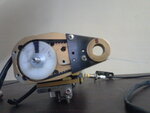Narendra1190
Member level 2
hii, i am designing an application in which i need to turn motor shaft BACK AND FORTH from 0 degree to around 190 degree (any fixed angle between 180-210) at HIGH SPEED AS POSSIBLE...which motor would be best in terms of Speed??..DC,SERVO,STEPPER??. angle accuracy is not necessary..jst need little more than 180 degree...help me.
